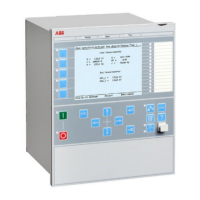0.2 £ f(Ucos) £ 8Hz
AND
AND
START
Z cross line ZA - ZC
Z cross line ZC - ZB
AND
AND
ZONE1
ZONE2
Counter
a
b
a ³ b
AND
TRIP1
Counter
a
b
a ³ b
AND
TRIP2
OR
TRIP
IEC07000100_2_en.vsd
Imin > 0.10 IBase
Umax < 0.92 UBase
d ³ StartAngle
N1Limit
d £ TripAngle
N2Limit
IEC07000100 V2 EN-US
Figure 39: Logic diagram of the pole slip protection PSPPPAM
11.4.11.2 Completing the test
SEMOD175096-39 v2
Continue to test another function or end the test by changing the TESTMODE
setting to Off. Restore connections and settings to their original values, if they were
changed for testing purposes.
11.4.12 Out-of-step protection OOSPPAM
GUID-BF2F7D4C-F579-4EBD-9AFC-7C03296BD5D4 v8
The out-of-step protection (OOSPPAM ) function in the IED can be used for both
generator protection and as well for line protection applications.
The main purpose of the OOSPPAM function is to detect, evaluate, and take the
required action during pole slipping occurrences in the power system.
The OOSPPAM function detects pole slip conditions and trips the generator as fast
as possible, after the first pole-slip if the center of oscillation is found to be in zone
1, which normally includes the generator and its step-up power transformer. If the
center of oscillation is found to be further out in the power system, in zone 2, more
than one pole-slip is usually allowed before the generator-transformer unit is
disconnected. A parameter setting is available to take into account the circuit
breaker opening time. If there are several out-of-step relays in the power system,
then the one which finds the center of oscillation in its zone 1 should operate first.
1MRK 505 378-UEN A Section 11
Testing functionality by secondary injection
Line differential protection RED670 2.2 IEC 149
Commissioning manual

